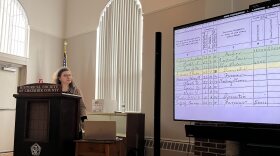This story was originally produced by the Keene Sentinel. NHPR is republishing it in partnership with the Granite State News Collaborative.
Sometimes, when a Cheshire County EMS first-responder rushes to save a life, the department ends up losing money.
That’s because the county’s ambulance service responds to every call it receives for support, but may not get paid if the patient is uninsured, or refuses transfer. It’s an issue that Deputy Chief Mark Kreamer has dealt with for years in the departments he’s worked at.
“It’s significant,” said Kreamer, who estimates that roughly 10 percent of EMS calls are unreimbursed. Kreamer said the department anticipates having gone on 5,500 EMS calls by the end of 2025.
The Keene Fire Department, which also responds to medical calls, has faced a similar issue, according to Deputy Chief Greg Seymour.
But now, as the county government prepares for recently-passed federal health care cuts to begin taking effect, it’s anticipating more calls could go unreimbursed.
“If all of a sudden we see an increase in people that don’t have any level of insurance coverage because they’ve lost their Medicaid, ... that’s a revenue loss,” County Administrator Chris Coates said.
The calls that cost Cheshire County EMS the most are those in which the ambulance does not take a patient to the hospital, Kreamer explained. This can range from cardiac arrests or when a patient’s overdose is reversed with Narcan. The most frequent of these calls are when someone needs non-lifesaving assistance, Kreamer said. For instance, this includes calls from people who don’t have in-home care who need to be moved after a fall.
“It’s a service we’re happy to perform,” Kreamer said. “But I only have so many ambulances.”
Coates said he anticipates that an increase in losses will affect the rural areas of the region the most if the EMS system is strained further.
“If they’re going to scenes where somebody’s not transferred, and we’re adding more [uninsured patients] onto that, it’s only going to put at risk the whole system,” Coates said.
Since many of the cuts won’t take affect until January, how it will affect the county’s finances is yet to be seen, according to Cheshire County Finance Director Sheryl Trombly. She noted that the losses could be offset by reimbursement increases from private insurers, but “it’s so uncertain,” she said.
Additionally, Kreamer worries that if uninsured patients forgo outpatient treatment, the ambulance will face more unreimbursed costs when they reach a point of crisis. In that situation, Kreamer said, “the emergency room becomes your primary care.”
These concerns are shared by Keene Fire Department Deputy Chief Seymour. The department frequently responds to medical emergency calls that don’t require a transport to the hospital, costing the department money. If the population of uninsured patients or patients who can’t afford to pay continues growing, Seymour said, it could increase the department’s loss from medical calls.
“A lot of people we deal with may not have insurance,” Seymour said, noting that the department frequently provides care to unhoused people who are unable to pay, and seniors who don’t require a transport. “That’s the trend we’re in now.”
When the department spends its time, labor and resources providing lifesaving medical care that doesn’t require a hospital transfer, it creates a “significant amount” of financial loss, Seymour described.
“We’re always chasing a moving target.”
Elijah de Castro can be reached at 603-355-8577 or edecastro@keenesentinel.com.
Funding for the Monadnock Region Health Reporting Lab comes from several sources, including The Sentinel and several local businesses and private donors, along with support from the Granite State News Collaborative. We continue to seek additional support. The newsroom maintains full editorial control over all content produced by the lab.
These articles are being shared by partners in the Granite State News Collaborative. For more information, visit collaborativenh.org.







